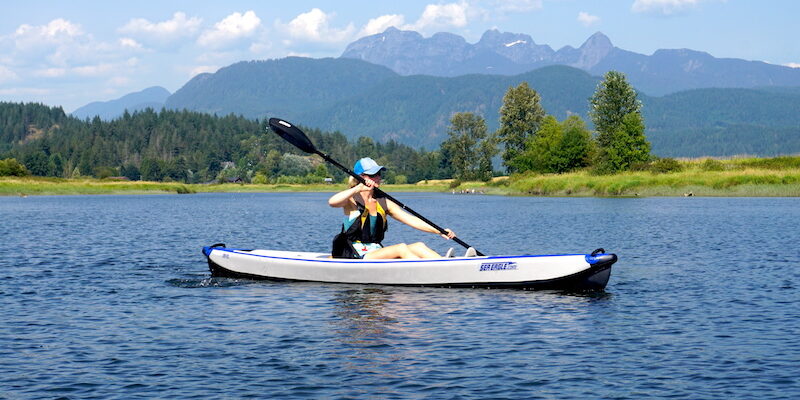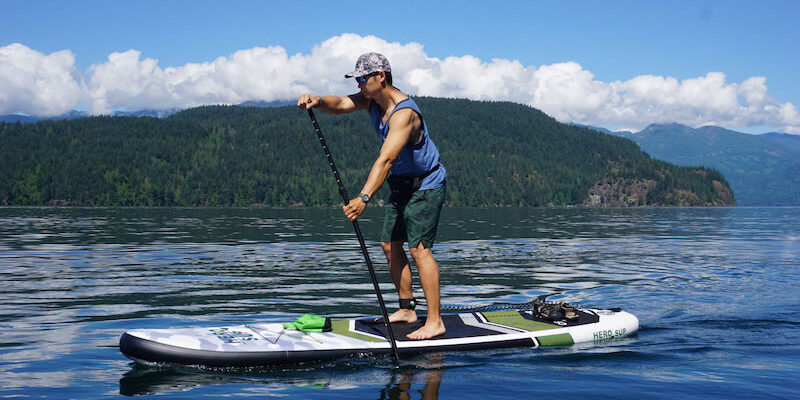If you are new to inflatable kayaking there are a few things you will need to know.
I will go through 5 basic lessons to help get any person started and comfortable with the inflatable kayak world.
These lessons will be broken up into two separate posts with this post containing the first three lessons which will include how to choose your inflatable kayak, proper care and repair as well as storage and transportation.
The second post will contain the last two lessons which will be what to know for your first time out and how to properly gear up.
Beginner Inflatable Kayaking Lessons
Lesson #1 – Choosing your Inflatable Kayak
If you have done any research up to this point you will have noticed that there are a lot of different models to choose from.
Which one you ultimately end up buying will depend on 5 things:
1. Type of Water
Which type of water will you be paddling in most? For example, either lakes, rivers, or on the ocean.
Some models are able to crossover and be paddled on more than one type of water but many are specialized for certain types of paddling.
2. Size
Do you want a solo kayak, a tandem kayak or a family sized model?
This will depend on if you plan to mostly be paddling solo or want the ability to bring along a friend or have room for extra gear.
Many tandem inflatable kayaks have the versatility of being able to move the seats to be paddled solo as well which can be very convenient.
3. Weight Capacity
Each different model has a different weight capacity. It is worth considering how much weight you need your kayak to be able to hold.
It is practically impossible to sink an inflatable kayak by weight alone but if you exceed the model’s weight capacity the performance will become sluggish and frustrating.
Therefore when looking at the different models consider your own weight, the weight of possible family and friends that may paddle with you as well as how much gear and cargo you will need to bring with you.
4. Weight of Kayak
The actual weight of inflatable kayaks and inflatable canoes can vary greatly. If you will be mostly paddling solo consider how much you are easily able to lift yourself.
Weight may also be an issue if you plan to bring it with you traveling or need to be able to carry it by foot so make sure you really check out the specs of the different models before you buy.
5. Price
There is quite a large range in pricing for inflatable kayaks starting around $100 and going right up into the thousands.
As with most things the quality of inflatable kayaks tends to get better as the price goes up.
However that does not mean you have to dish out for a top of the line price tag in order to get a decent model.
The average range for a good quality inflatable kayak that will last a very long time and give a decent performance is anywhere between $300 and $1500.
How much you spend will depend of course on what you can afford as well as how often you will use your kayak.
The cheaper models work great for newbies, kids, camping or to be used as a second inflatable for friends or guests.
However if you are able to invest in a slightly better model you will get much more of a real ’kayaking’ experience complete with good tracking, good speed and rigid construction as well as a good warranty.
Lesson # 2 – Proper Care & Repair
What I love most about inflatable kayaks is that there is not much you have to do with it once you have it.
Proper care is a very simple three step process:
1. Purchase a bottle of UV Protectant spray which is available at just about all inflatable boat stores.
Spray this on your inflatable every few months (while in use) to help protect the material from UV damage and exposure to the elements.
This will keep your kayak material strong and greatly prolong its life.
2. After use, dry out your inflatable with a towel and store in a dry, cool place.
If your kayak is stored for any great length of time with a lot of water or moisture left in it then it may end up growing mold or mildew.
Simply towel dry after each use and this will not be a problem.
3. If your inflatable ends up with grass, dirt, oil, or any other tough stains simply use an inflatable boat cleaner to remove.
You can even just use a regular all purpose cleaner that you have at home if it is safe and natural.
Be careful of harsh chemicals as this could weaken your kayak material.
Repairs
It is possible that at some point you may need to repair your inflatable kayak… this will depend on the amount of abuse it takes.
I personally have never had a rip or a leak in my kayak material after several years of use so repairs are truly few and far between.
A cheaper model will not have the same strong material so may need repairs more often.
The good quality brand names tend to make models with reinforced and strong material making leaks far less possible.
Each inflatable boat will come with its own repair kit. This repair kit is easy to bring along with you and should be a staple in your dry bag each time you go out.
Read the instructions upon receiving it so you are familiar with how to use it if you ever need to.
Lesson # 3 – Storage and Transportation
Inflatable kayaks are versatile and convenient for two main reasons:
- They are easy to pack up and store in small spaces
- They are easy to transport to just about anywhere you want to go
Storage is easy, you have two choices…
You can completely dry it out, fold it up and pack it into its storage bag (each model comes with its own storage bag), then store it in your garage, in a closet or in any dry and cool space.
Or you can leave it inflated and store it in a dry, cool space or else hang it up outside or in your garage on a kayak rack.
As for transportation, inflatable kayaks and inflatable canoes are known to easily transport in the trunk of your car, in the back of your vehicle or RV, or if you choose to leave it inflated you can tie it down on the roof of your vehicle.
Some models are light enough to be checked on an airplane while others are so light you can even carry them in a backpack by foot or by bicycle. They are perfect for bringing along everywhere!
The next post will cover the last two beginner inflatable kayaking lessons to help you get started on the right foot.
To search the different inflatable kayak models please see our inflatable reviews.


What info/experience do you have behind your statement that an inflatable kayak can be tied down on the roof of a car? Innova, the maker of my kayak, specifically said that is not recommended. I would like to be able to do that, but not if it risks harm to the kayak.
Hi Beth, I’ve done it a couple times myself but only when going short distances and didn’t have any issues. I think the manufacturers don’t recommend it because they don’t want to be responsible for any damage, which I can understand.